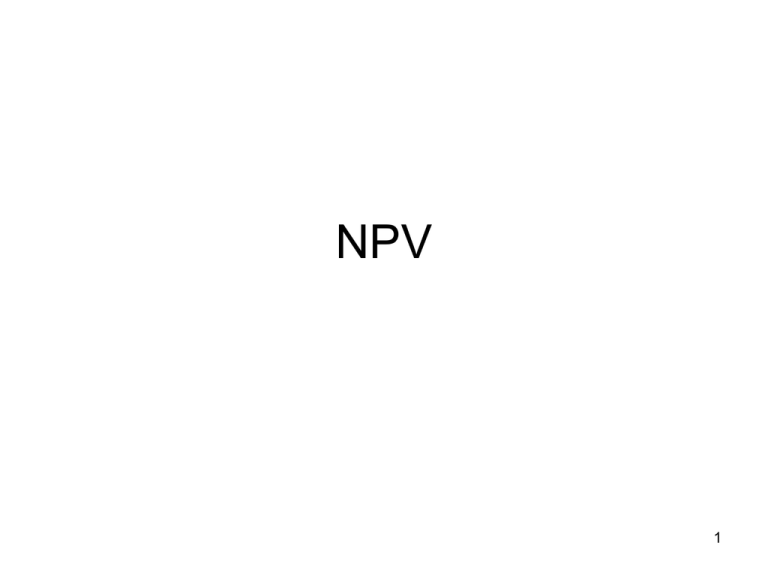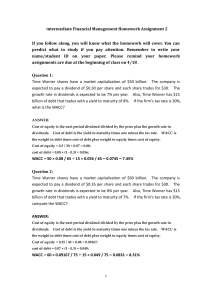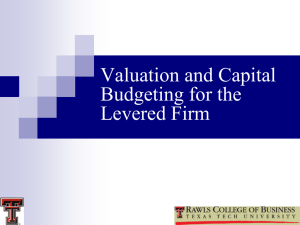NPV
advertisement

NPV 1 NPV • There are three ways to apply the NPV principle • Weighted Average Cost of Capital (WACC) • Adjusted Present Value (APV) • Flow to Equity (FTE) 2 NPV WACC • Work out the WACC using the after tax cost of debt • Rwacc = E re + D rd (1-Tc) E+D E+D E = market value of equity D = market value of debt Tc = marginal corporate tax rate re = equity cost of capital rd = debt cost of capital 3 NPV WACC rwacc E D rE rD (1 c ) E D E D – Because the WACC incorporates the tax savings from debt, we can compute the levered value of an investment, by discounting its future free cash flow using the WACC. L 0 V FCF3 FCF1 FCF2 2 3 1 rwacc (1 rwacc ) (1 rwacc ) 4 NPV WACC Assume Avco is considering introducing a new line of packaging, the RFX Series. Avco expects the technology used in these products to become obsolete after four years. However, the marketing group expects annual sales of $60 million per year over the next four years for this product line. Manufacturing costs and operating expenses are expected to be $25 million and $9 million, respectively, per year. 5 NPV WACC – Developing the product will require upfront R&D and marketing expenses of $6.67 million, together with a $24 million investment in equipment. • The equipment will be obsolete in four years and will be depreciated via the straight-line method over that period. – Avco expects no net working capital requirements for the project. – Avco pays a corporate tax rate of 40%. 6 NPV WACC 7 NPV WACC NB Net debt used i.e. less cash 8 NPV WACC • Avco intends to maintain a similar (net) debt-equity ratio for the foreseeable future, including any financing related to the RFX project. Thus, Avco’s WACC is rwacc E D 300 300 rE rD (1 c ) (10%) (6%)(1 0.40) E D E D 600 600 6.8% 9 NPV WACC • The value of the project, including the tax shield from debt, is calculated as the present value of its future free cash flows. V0L 18 18 18 18 $61.25 million 2 3 1.068 1.068 1.068 1.0684 • The NPV of the project is $33.25 million $61.25 million – $28 million = $33.25 million 10 NPV WACC Implementing a Constant Debt-Equity Ratio • By undertaking the RFX project, Avco adds new assets to the firm with initial market value $61.25 million. – Therefore, to maintain its debt-to-value ratio, Avco must add $30.625 million in new debt. • 50% × 61.25 = $30.625 11 NPV WACC • Avco can add this debt either by reducing cash and/or by borrowing and increasing debt. – Assume Avco decides to spend its $20 million in cash and borrow an additional $10.625 million. • Because only $28 million is required to fund the project, Avco will pay the remaining $2.625 million to shareholders through a dividend (or share repurchase). – $30.625 million − $28 million = $2.625 million 12 NPV WACC 13 • The market value of Avco’s equity increases by $30.625 million. $330.625 − $300 = $30.625 • Adding the dividend of $2.625 million, the shareholders’ total gain is $33.25 million. $30.625 + 2.625 = $33.25 – Which is exactly the NPV calculated for the RFX project 14 NPV WACC • Debt Capacity – The amount of debt at a particular date that is required to maintain the firm’s target debt-to-value ratio – The debt capacity at date t is calculated as: Dt d Vt L • Where d is the firm’s target debt-to-value ratio and VLt is the levered continuation value on date t. 15 NPV WACC • Implementing a Constant Debt-Equity Ratio (cont'd) • Debt Capacity – VLt calculated as: Value of FCF in year t 2 and beyond Vt L FCFt 1 L t 1 V 1 rwacc 16 NPV WACC • Table 18.4 e.g. 47.41 = 18/1.068 + 18/1.1406 +18/1.218 17 NPV The Adjusted Present Value Method Adjusted Present Value (APV) – A valuation method to determine the levered value of an investment by first calculating its unlevered value and then adding the value of the interest tax shield and deducting any costs that arise from other market imperfections V L APV V U PV (Interest Tax Shield) PV (Financial Distress, Agency, and Issuance Costs) 18 NPV APV • We first need to calculate the unlevered value • Then add the value of the tax shield plus any other costs • To calculate unlevered value need the unlevered cost of equity • The unlevered cost of equity will equal the pre tax WACC 19 NPV APV rU 0.50 10.0% 0.50 6.0% 8.0% rU VU E rE E D D rD Pretax WACC E D 18 18 18 18 $59.62 million 2 3 4 1.08 1.08 1.08 1.08 20 NPV APV • The value of $59.62 million is the value of the unlevered project and does not include the value of the tax shield provided by the interest payments on debt. • The interest tax shield is equal to the interest paid multiplied by the corporate tax rate. 21 NPV APV • Now value the tax shield We know from slide 17 what the debt capacity is 1.84 = 30.62 x .06 and 1.84 x .4 = .73 22 • The next step is to find the present value of the interest tax shield. – When the firm maintains a target leverage ratio, its future interest tax shields have similar risk to the project’s cash flows, so they should be discounted at the project’s unlevered cost of capital. 0.73 0.57 0.39 0.20 PV (interest tax shield) $1.63 million 2 3 4 1.08 1.08 1.08 1.08 23 NPV APV • The total value of the project with leverage is the sum of the value of the interest tax shield and the value of the unlevered project. V L V U PV (interest tax shield) 59.62 1.63 $61.25 million – The NPV of the project is $33.25 million • $61.25 million – $28 million = $33.25 million – This is exactly the same value found using the WACC approach. 24 NPV APV 1. Determine the investment’s value without leverage. 2. Determine the present value of the interest tax shield. a. Determine the expected interest tax shield. b. Discount the interest tax shield. 3. Add the unlevered value to the present value of the interest tax shield to determine the value of the investment with leverage. 25 NPV APV • More complex to use as have to: - compute unlevered cost of equity - compute value of tax shield • So when would you use it? - easier to apply when a constant debt equity ratio not going to be used - explicitly includes earnings and costs due to debt 26 NPV FTE • Flow-to-Equity – A valuation method that calculates the free cash flow available to equity holders taking into account all payments to and from debt holders – The cash flows to equity holders are then discounted using the equity cost of capital. 27 NPV FTE • Free Cash Flow to Equity (FCFE) – The free cash flow that remains after adjusting for interest payments, debt issuance and debt repayments • The first step in the FTE method is to determine the project’s free cash flow to equity. • Then discount them using the cost of equity 28 NPV FTE 29 NPV FTE • Because the FCFE represent payments to equity holders, they should be discounted at the project’s equity cost of capital. – Given that the risk and leverage of the RFX project are the same as for Avco overall, we can use Avco’s equity cost of capital of 10.0% to discount the project’s FCFE. 9.98 9.76 9.52 9.27 NPV (FCFE ) 2.62 $33.25 million 2 3 4 1.10 1.10 1.10 1.10 30 NPV FTE 1. Determine the free cash flow to equity of the investment. 2. Determine the equity cost of capital. 3. Compute the equity value by discounting the free cash flow to equity using the equity cost of capital. 31 NPV FTE • The FTE method offers some advantages. – It may be simpler to use when calculating the value of equity for the entire firm, if the firm’s capital structure is complex and the market values of other securities in the firm’s capital structure are not known. – It may be viewed as a more transparent method for discussing a project’s benefit to shareholders by emphasizing a project’s implication for equity. • The FTE method has a disadvantage. – One must compute the project’s debt capacity to determine the interest and net borrowing before capital budgeting decisions can be made. 32







